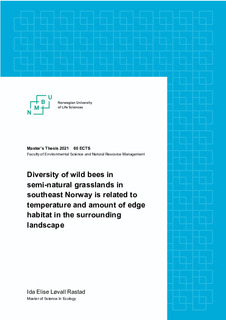| dc.description.abstract | The declines in diversity and abundance of wild bees are mainly attributed to the intensification of agricultural practices and the resulting loss of semi-natural grassland habitats. Furthermore, the effect of climate change (i.e., rising temperatures) pose an additional concern for wild bees (and other insect pollinators). However, the potential interactive effects of rising temperatures and habitat characteris- tics are poorly understood.
The aim of this study was to explore the interactive effects of temperature and different landscape at- tributes (amount of edge habitat, amount of semi-natural grasslands, distance to coastline, landscape diversity). I sampled wild bees from 20 semi-natural grasslands in southeast Norway to supplement an existing dataset containing data from 32 such grasslands. Using data from all 52 sites, I analysed how bee species richness, total abundance and Shannon diversity varied across the sites, in relation to tem- perature, distance to the coastline, and area-dependent landscape attributes quantified within radii of 250, 450 and 650 m around each site.
My results indicate that rising temperatures and habitat area (amount of edge habitat) have a positive effect on wild bee diversity. However, the positive effect of edge habitat was modified by tempera- ture, and the importance of edge habitat decreased with increasing temperature. Consequently, the amount of habitat area (edge) was only important for wild bee diversity at lower temperatures.
My findings suggest that within southeastern Norway, climatic factors were more important for wild bee diversity than availability of suitable habitat. However, wild bees undergoing thermal stress from colder temperatures showed increased dependancy on habitat amount (edges). With the impending implications of climate change, a better understanding of the interactive effects of climatic conditions and the surrounding landscape context could help ensure the viability of wild bee communities in the future. | en_US |

